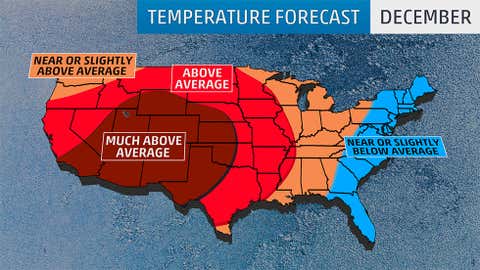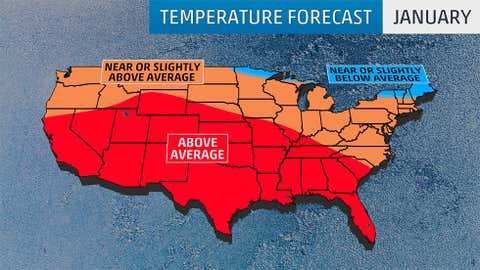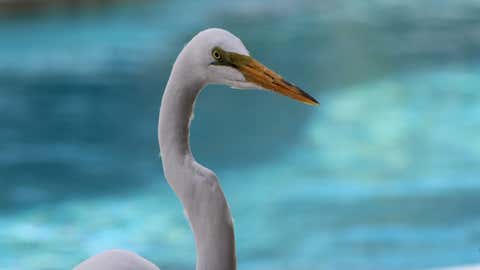When Will It Be Cold Again 2017
- The upcoming winter may be quite different temperature-wise in parts of the United States.
- There'south a risk for a somewhat colder winter in the East, particularly early in the season.
- Generally, a balmy wintertime is one time again expected over much of the residuum of the nation.
Winter 2016-17 may be colder in the East, but leftover warmth from the recent El Niño may dominate elsewhere in the U.S., co-ordinate to an outlook released Friday by The Weather Company, an IBM Business organization.
New England and Upstate New York may run across a cooler-than-average December-February, while the rest of the Lower 48 states could feel still another mild winter temperature-wise, said Dr. Todd Crawford, chief meteorologist with The Weather Company.
(MORE: Winter Storm Primal)

December 2016 - February 2017 temperature outlook from The Weather Company, an IBM Concern, released Friday. September 23, 2016.
Any colder-than-average air in the Eastward may not persist long this wintertime, according to Crawford, thanks, in part, to the change to neutral or weak La Niña weather in the equatorial Pacific Ocean.
"The reversal of tropical forcing suggests that the coldest weather in the eastern U.S, may occur earlier in the winter, with increasing chances for warmth during the late winter," Crawford said in the release.
The regular cycle of sea-surface temperature anomalies in the Pacific Body of water can lead to shifting patterns of convection, which then help influence dominant weather patterns downstream over North America.
Contrasting with this dank get-go to wintertime in the E is relatively loftier confidence in a warm Dec from the Plains to the West, particularly over the cardinal and southern Rockies and Desert Southwest.

Dec 2016 temperature outlook from The Weather condition Company, an IBM Business, released Fri. September 23, 2016.
Jan's outlook reflects the potentially warmer East.
"The expected lack of (atmospheric) blocking should effect in the bulk of Chill air sliding eastward, with but glancing blows into the eastern U.S.," Crawford said.

January 2017 temperature outlook from The Weather Company, an IBM Concern, released September 23, 2016.
"Blocking" refers to atmospheric patterns like the "Greenland cake," an surface area of high pressure level aloft over the north Atlantic Ocean about Greenland that helps Arctic air plunge and lock into the central and eastern U.S. at times.
A lack of such a blocking pattern would allow the coldest air to bleed from west to east off Canada, or if it does plunge into the U.Due south., it would practice so quickly and non lock in place for an extended period.
"Climate model forecasts for winter are unusually warm, likely reflecting the excess post-El-Nino global warmth, and another very warm wintertime is not out of the question due to this cistron alone."

States shaded in red had a record warm Dec-February catamenia in 2015-2016. States in orange were much above average during the three cadre winter months. The numbers signify land temperature rankings, with a ranking of 121 meaning it was the record warmest December through February catamenia on record, while a i ways information technology was the record coldest such flow for that country. A ranking of 120, for example, means it was the 2d warmest December-Feb catamenia in that land.
(NOAA/NCEI)
Winter 2015-2016 was the Lower 48's warmest December-February period in 121 years or records, according to NOAA's National Centers for Environmental Information.
(Epitomize: Record Warmest U.S. Winter)
Thirty-six states had one of their summit x warmest winters, and at to the lowest degree 14 cities with a period of record of at least sixty years had their record warmest winter last season.
Interestingly enough, a miracle called "The Blob" may as well take an influence on the winter alee.
This area of anomalously warm h2o in the northern Pacific Body of water reappeared at the end of summertime 2016.
Crawford's team looked for by winters with similar sea-surface temperature anomalies. Namely, they found analog winters with weak La Niña conditions that followed El Niño the previous wintertime also as the warm Northward Pacific anomalies seen now.
I wintertime was the closest match: 1995-96.
That flavor was particularly cold from the northern Plains and upper Midwest to the East. Withal, Crawford said in that location was considerable atmospheric blocking in the college latitudes, alluded to earlier, that played a considerable role.
This was at least partially a result of low sunspot activity, also known as a solar minimum. Since the 1970s, it is rare to see a winter with frequent blocking patterns when sunspot activeness isn't almost a minimum, which won't happen for some other couple of years, according to Crawford.
Furthermore, the temper however exhibits a warmth hangover from the record-tying stiff El Niño of 2015-16.
Of course, none of this necessarily implies a winter without impactful winter storms.
Despite the notably warm winter, late Jan'south Winter Storm Jonas was one of the heaviest snowstorms on record in several Eastern cities.
MORE ON WEATHER.COM: Winter Storm Jonas - Jan 2016

mcclurehopentionet.blogspot.com
Source: https://weather.com/storms/winter/news/winter-outlook-2016-2017-twc
0 Response to "When Will It Be Cold Again 2017"
Post a Comment